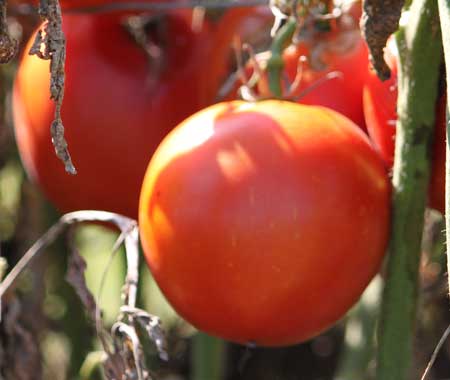Tomatoes are America’s favorite garden vegetable. One big reason for that is tomatoes are pretty easy to grow. Still, there are problems you could face when you’re growing them. If you’ve experienced difficulty raising “maters”, you may be interested in some disease resistant varieties and hybrids. But codes like “VF”, “VFFA”, and “VFNT” can be somewhat obscure.
What different types of problems are normal to tomatoes, and how can you tell if a particular variety is resistant to the disease you are encountering in your garden? The capital letters that follow the names of some tomatoes should tell you what disease resistances that type has.
Breaking the Code
“V” – indicates the plant is resistant to the fungi that cause Verticillium wilt, Verticillium dahliae and V. albo-atrum. Signs and symptoms of Verticillium wilt don’t usually arrive until the plant is bearing fruit or it goes through a dry period. Symptoms include V-shaped lesions on the leaves.
“F” or “FF” – means the plants are resistant to the Fusarium oxysporum fungi that cause Fusarium wilt. This is a serious disease that shows itself in the wilting and yellowing of leaves starting at the foot of the plant. Left unchecked, Fusarium wilt can kill tomato plants well before harvest time. Some Fusarium fungi have overcome the initial “F” resistance tomatoes. If your tomatoes are afflicted with this second type, choose plants with the “FF” designation.
“N” – means that the tomatoes are resistant to the parasitic round worms, nematodes that often lie dormant in the dirt. Symptoms of nematode infestation include root galls that are up to an inch in diameter. Afflicted plants are less healthy, do not respond to fertilizer, and tend to wither more easily in hot weather.
“A” – indicates resistance to the Alternaria alternata fungus that causes Alternaria stem canker. Tomato stems, leaves and fruit are afflicted with cankers that range from dark brown to black. If the cankers appear on the stem they can be accompanied by brown streaks. Stem cankers can girdle and kill a plant before harvest.
“T” – means that the plants are resistant to the Tobacco Mosaic Virus (TMV). TMV causes a mottled appearance in tomato leaves and reduced tomato size and yield. Sometimes unripe fruit of plants afflicted with TMV will brown.
“St” – designated plants are resistant to Stemphylium or gray leaf spot. Afflicted plants develop brown to black spots on older leaves. As the disease progresses, the spots get bigger while the center become gray. The gray centers eventually drop out, leaving behind small holes. The Stemphylium solani fungus causes gray leaf spot.
“TSWV” – indicates resistance to the Tomato Spotted Wilt Virus. Symptoms of infection vary widely between tomato species, but include yellow and brown rings and brown streaks on plant stems, dead leaf spots and tips, and severely reduced growth. Fruit may have red and orange discolorations at maturation.
Remember that resistance is not the same as immunity. Tomatoes such as Early Cascade VF Hybrid can still be attacked with Verticillium and Fusarium Wilt. They just won’t be as susceptible to harm as their non-resistant cousins.
Along with growing the appropriate resistant strains, you should use good gardening methods to keep these fungal, viral, and parasitic pests under control. Rotating your tomato crops with annual rye, alfalfa, peas or clover will prevent most nematodes and fungi from proliferation. Just make certain that you choose species and cultivars that do not harbor the particular pest you’re trying to control.
Soil solarization will kill off many more nematodes, fungi, and disease vectors (aka, weeds and larval insects).
By keeping your tomato plants as healthy and vibrant as they can be, good watering, drainage, and mulching also help control pests.
Finally, do NOT re-incorporate diseased plant matter into the soil at the end of the season — compost from a diseased plant will just infect your next crop, so it is best to either burn it or throw it away.
The trick to growing delectable tomatoes in your backyard is to find out what pests it already harbors, choose tomato varieties specifically resistant to those pests, and follow good gardening/pest-control techniques. Once you have grown a few good crops and have your pests down to a reasonable level, you can even move on to grow more exotic tomato varieties.

Comments on this entry are closed.